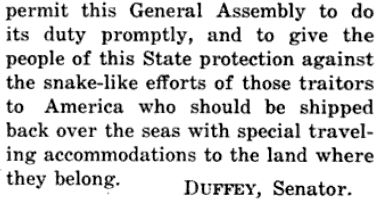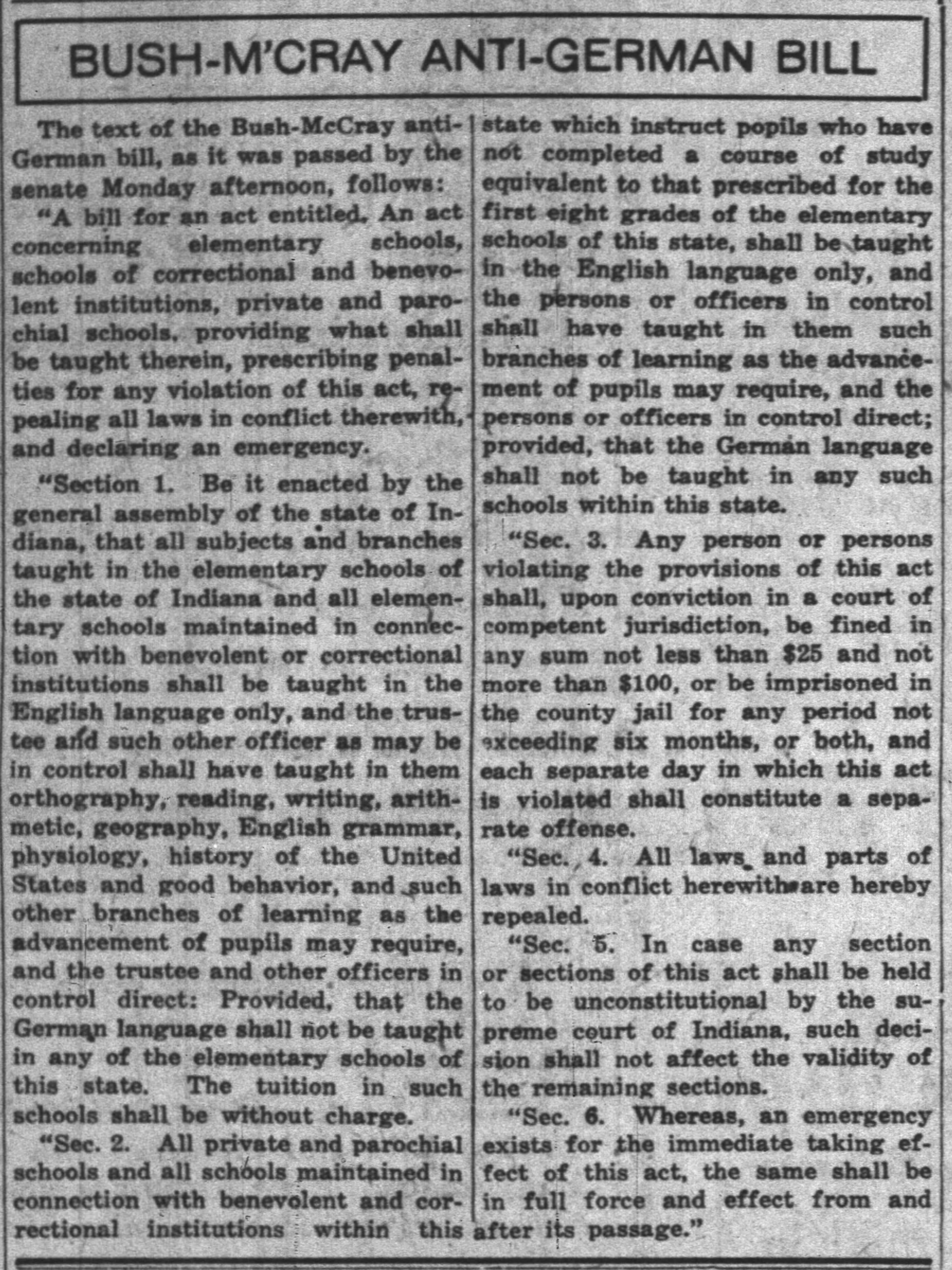
On February 25, 1919, three months after the armistice that ended World War I, the Hoosier State banned the teaching of German to children, one of 34 states to institute English-only requirements by the early 1920s.

From 1914 to 1918, the U.S. and its allies in Britain, France and Italy took dehumanizing propaganda to new heights. Cartoonists, U.S. Army posters, and newspapers stoked a bizarre, irrational distrust of Germans that engulfed America. The results were sometimes petty, like renaming sauerkraut “liberty cabbage” and German measles “liberty measles,” but the U.S. and Britain could also engage in acts of brutality.
One of the stranger instances of violence resulting from First World War propaganda was the war on dachshunds, considered to be a German breed. At the time the German language was being driven out of schools in England and the U.S., dachshunds were sometimes stoned or stomped to death in front of their owners. (Novelist Graham Greene remembered this in his autobiography, A Sort of Life.) When “patriots” harassed a Chicago dog breeder, he shot every dachshund in his kennels. Bulldogs, a symbol of Britain and the mascot of the U.S. Marines, were turned loose to attack and kill the “German” pets. The Jasper Weekly Courier, printed in a heavily German town in southern Indiana, carried a syndicated story about this:


(A website on pet health claims that “In the United States the poor Dachshund went from one of the ten most popular breeds in 1913 to being represented by 12 survivors in 1919.” A “lonely dachshund” showed up in Topeka, Kansas, that year in search of a home.)
With Allied print media insisting that the Kaiser’s soldiers were bayoneting and committing other outrages, it’s easy to see how anxiety got out of hand, even in areas like Pennsylvania and the Midwest, which had large German-American populations.
Indiana’s 1919 anti-German law wasn’t the first of its kind. Parents and school boards had already been striking German classes from school curricula before the U.S. even entered the war. And devaluing the German language was a coast-to-coast phenomenon. Evanston, Illinois, banned the language in its schools in 1918. California kept up a ban on high-school German into the 1920s and in 1941 banned it in churches. At a speech on Long Island in 1917, Theodore Roosevelt urged Americans to rid the country of German, otherwise America risked becoming “a polyglot counting house for dollar chasers.”
A sign painter in Indianapolis who opposed Gothic lettering mentioned that Americans were already burning German textbooks. At Indianapolis’ Shortridge High School, a newspaperwoman connected to the Red Cross was applauded during a speech when she criticized the administration for not canceling German classes there. The German teachers switched to teaching Latin. Meanwhile, a new course on “contemporary war history” began and a hundred students enrolled. At a time when the U.S. was claiming to oppose German militarism, Shortridge considered its military history course to be the first ever offered at an American public high school.

On the eve of the vote for banning German in schools, a visitor from Iowa spoke at the Statehouse in Indianapolis. Iowa’s Governor William L. Harding is considered one of the most controversial politicians in Iowa’s history. Though he had curried favor with Iowa’s foreign-born citizens during his election campaign, when the war broke out he turned against them. Proponents of Indiana’s German-language ban were later accused of the same kind of hypocrisy.

Harding’s 1918 “Babel Proclamation” in Iowa did more than simply ban German instruction, though. The infamous law banned the speaking of all foreign languages in public, including Norwegian, Swedish, Dutch and Czech, which were still common in the Midwest. Fearing “spies,” Harding made having a foreign-language conversation on the telephone, on street corners, and in churches and schools a criminal offense. Iowa’s law was no empty threat. Violators were arrested and jailed.
Harding had plenty of admirers. “Liberty Leagues” and “councils of defense” wanted laws to keep German off the streets and even ban it in private homes. The author of the “Babel Proclamation” spoke in Indianapolis on February 13, 1919, a few days before Indiana outlawed the teaching of German in Hoosier elementary schools.

The main proponent of Indiana’s bill was State Senator Franklin McCray of Indianapolis. As Lieutenant Governor Edgar Bush reminded the General Assembly, this bill would overturn a long-standing law dating back to the 1860s. Bush told the Senate:

Indiana’s 1869 law likely had to do with teacher shortages and the fact that in German communities, it just made sense.
One of the most glaring oversights of the anti-German law was that many speakers of the language were Mennonites and Amish, Christian pacifists highly unlikely to be working as secret agents.
Though the German army committed real outrages in World War I and the bill’s proponents mentioned fear of “future German propaganda” aimed at American children, focusing on the atrocities of Germans was a sly way to pass a law that was deeply entangled with immigration, prohibition and labor unrest. As 1919 dawned — one of the most turbulent years in American history — “wet” and “dry” advocates, capitalists and socialists, anarchists, pacifists and suffragettes battled for the “soul” of the country.
Many German-Americans were farmers or industrial laborers and had a history of being Socialists, pacifists and isolationists. When the Socialist Party tried to steer America away from entering World War I, arguing that American entry would play into the hands of wealthy industrialists and bankers, pro-war advocates countered that anyone who opposed the war supported the Kaiser. In 1924, Progressive Party presidential candidate Robert LaFollette carried Wisconsin, a heavily-German state, partly as a result of his anti-war record.
The perception of German fondness for beer and liquor also earned the hostility of many Prohibition advocates, who had spent decades slowly “shutting off the tap.” A nationwide ban on booze was just around the corner, coming in January 1920. Yet as Chicago’s Lager Beer Riot back in 1855 proved, the history of Prohibition was closely tied to anti-labor attitudes. Squelching the German language was part of the process of extinguishing German sociability at a time when workers got together in pubs and beer gardens to talk about labor grievances and organize.


While fear of “Huns” and “traitors” prompted anti-German legislation, America’s social problems were reflected in the Indiana bill. That year, Gary would be shut down by a national steel strike, a federal raid on Communists led to the deportation of hundreds of European immigrants (including Hoosiers), and an anarchist bomb plot nearly killed several major U.S. officials.
Although the language of the Indiana law would be more formal, State Senator Luke W. Duffey, speaking on the Senate floor, lashed out at the “stupid heads” of Germany and their sympathizers in America, who threatened to strangle education and spread disloyalty. Duffey finished off with a call for deporting traitors. He didn’t know it yet, but he was sounding the keynote of 1919:

The anti-German bill was about more than bigotry against German culture; it was also about stamping out the perception of political radicalism. Many people who supported the law had German last names, after all, like Speaker of the House Jesse E. Eschbach. Lieutenant Governor Bush read a letter at the Statehouse from “150 residents of Seymour of German extraction” who favored the language ban and asked why it was taking so long. The Germans of Seymour probably didn’t want to be associated with those deemed “subversives,” “traitors” and “terrorists.”
Urged by the Lieutenant Governor to enact “100 percent American” legislation, the Senate put the elementary-school bill up for a vote on February 17, 1919. Only one legislator, Senator Charles A. Hagerty of South Bend, voted against it. Yet even Hagerty’s opposition seems to have been against the political opportunism of the bill’s promoters rather than a real concern for education. On February 25, the House also passed the bill and Governor James P. Goodrich signed the legislation.
The South Bend News-Times, a liberal paper, thought the bill a classic case of legislative overreach, since most German-Americans were already trying hard to adopt English in their churches and schools. McCray had insisted that it would not interfere with the use of foreign languages in religious worship. (Many Lutheran churches still used German, and it was the main language of instruction at a few major Catholic seminaries.)
The 1919 law completely banned German-language instruction up to the eighth grade. The penalty for instructing children in German? A fine of $25 to $100, a jail sentence of up to six months, or both. It was followed by a law prohibiting high-school German courses.

Ironically, the anti-German bills were overturned in 1923 by another man named McCray — Governor Warren T. McCray, who also butted heads with the Klan.
A few months after Governor Goodrich signed Indiana’s law, an anti-German bill passed through Pennsylvania’s legislature, also by a large margin. Pennsylvania Governor William C. Sproul, however, vetoed it. Sproul’s remarks to the press were probably the most intelligent words to come out of the whole debate. They are below and well worth reading in full:

Indiana’s anti-German bills were overturned in 1923 by another man named McCray — Governor Warren T. McCray, who is best remembered today for taking on another wave of intolerance in Indiana, the Ku Klux Klan. Despite their removal almost a century ago, Indiana’s anti-German laws serve as a powerful example of how extreme nationalism during wartime can lead to discriminatory government policy.
Hoosier State Chronicles has digitized over 8,000 issues of the Indiana Tribüne, once a major German-language newspaper. Published by The Gutenberg Company in Indianapolis, the Tribüne was silenced on June 1, 1918.















